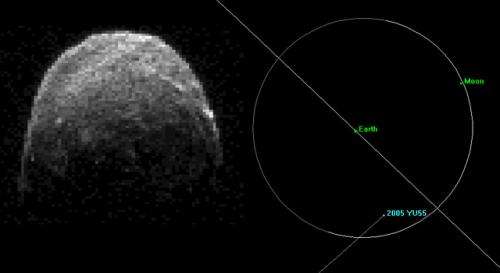NASA releases radar movie of asteroid 2005 YU55

(PhysOrg.com) -- Scientists working with the 230-foot-wide (70-meter) Deep Space Network antenna at Goldstone, Calif., have generated a short movie clip of asteroid 2005 YU55. The images were generated from data collected at Goldstone on Nov. 7, 2011, between 11:24 a.m. and 1:35 p.m. PST (2:24 p.m. and 4:35 p.m. EST). They are the highest-resolution images ever generated by radar of a near-Earth object.
Each of the six frames required 20 minutes of data collection by the Goldstone radar. At the time, 2005 YU55 was approximately 860,000 miles (1.38 million kilometers) away from Earth. Resolution is 4 meters per pixel.
"The movie shows the small subset of images obtained at Goldstone on November 7 that have finished processing. By animating a sequence of radar images, we can see more surface detail than is visible otherwise," said radar astronomer Lance Benner, the principal investigator for the 2005 YU55 observations, from NASA's Jet Propulsion Laboratory in Pasadena, Calif. "The animation reveals a number of puzzling structures on the surface that we don't yet understand. To date, we've seen less than one half of the surface, so we expect more surprises."
The trajectory of asteroid 2005 YU55 is well understood. At the point of closest approach today at 3:28 p.m. PST (6:28 p.m. EST/2328 UTC), it was no closer than 201,700 miles (324,600 kilometers), as measured from the center of Earth. The gravitational influence of the asteroid will have no detectable effect on anything here on Earth, including our planet's tides or tectonic plates. Although 2005 YU55 is in an orbit that regularly brings it to the vicinity of Earth (and Venus and Mars), the 2011 encounter with Earth is the closest this space rock has come for at least the last 200 years.
The last time a space rock as big came as close to Earth was in 1976, although astronomers did not know about the flyby at the time. The next known approach of an asteroid this large will be in 2028.
NASA detects, tracks and characterizes asteroids and comets passing close to Earth using both ground- and space-based telescopes. The Near-Earth Object Observations Program, commonly called "Spaceguard," discovers these objects, characterizes a subset of them, and plots their orbits to determine if any could be potentially hazardous to our planet.
Provided by JPL/NASA



















